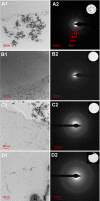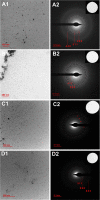Magnetite Mineralization inside Cross-Linked Protein Crystals
- PMID: 37304398
- PMCID: PMC10251750
- DOI: 10.1021/acs.cgd.2c01436
Magnetite Mineralization inside Cross-Linked Protein Crystals
Abstract
Crystallization in confined spaces is a widespread process in nature that also has important implications for the stability and durability of many man-made materials. It has been reported that confinement can alter essential crystallization events, such as nucleation and growth and, thus, have an impact on crystal size, polymorphism, morphology, and stability. Therefore, the study of nucleation in confined spaces can help us understand similar events that occur in nature, such as biomineralization, design new methods to control crystallization, and expand our knowledge in the field of crystallography. Although the fundamental interest is clear, basic models at the laboratory scale are scarce mainly due to the difficulty in obtaining well-defined confined spaces allowing a simultaneous study of the mineralization process outside and inside the cavities. Herein, we have studied magnetite precipitation in the channels of cross-linked protein crystals (CLPCs) with different channel pore sizes, as a model of crystallization in confined spaces. Our results show that nucleation of an Fe-rich phase occurs inside the protein channels in all cases, but, by a combination of chemical and physical effects, the channel diameter of CLPCs exerted a precise control on the size and stability of those Fe-rich nanoparticles. The small diameters of protein channels restrain the growth of metastable intermediates to around 2 nm and stabilize them over time. At larger pore diameters, recrystallization of the Fe-rich precursors into more stable phases was observed. This study highlights the impact that crystallization in confined spaces can have on the physicochemical properties of the resulting crystals and shows that CLPCs can be interesting substrates to study this process.
© 2023 The Authors. Published by American Chemical Society.
Conflict of interest statement
The authors declare no competing financial interest.
Figures








References
-
- Mann S.Biomineralization: Principles and Concepts in Bioinorganic Materials Chemistry; Oxford chemistry masters; Oxford University Press, 2001.
-
- Mañas-Torres M. C.; Ramírez-Rodríguez G. B.; García-Peiro J. I.; Parra-Torrejón B.; Cuerva J. M.; Lopez-Lopez M. T.; Álvarez De Cienfuegos L.; Delgado-López J. M. Organic/Inorganic Hydrogels by Simultaneous Self-Assembly and Mineralization of Aromatic Short-Peptides. Inorg. Chem. Front. 2022, 9, 743–752. 10.1039/d1qi01249e. - DOI
LinkOut - more resources
Full Text Sources
